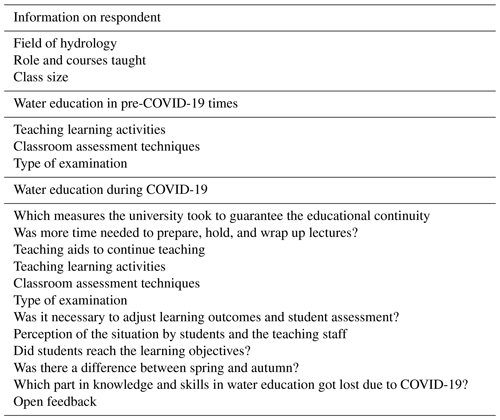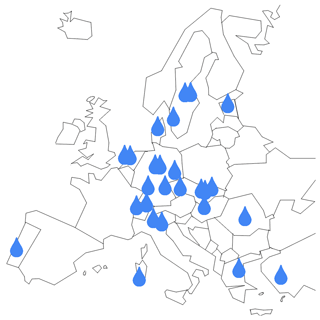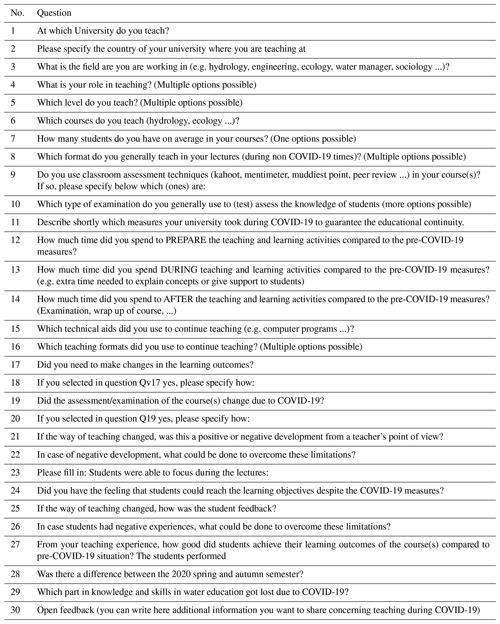the Creative Commons Attribution 4.0 License.
the Creative Commons Attribution 4.0 License.
A snapshot sample on how COVID-19 impacted and holds up a mirror to European water education
Benjamin M. C. Fischer
Alexandru Tatomir
COVID-19 caused many disruptions, not only in society, but also in university education, including in hydrology and water-related sciences. Taking part in an academic teaching training course at Uppsala University during COVID-19, we got curious about how COVID-19 might have impacted European water education. Consequently, we chose to investigate this aspect in the mandatory project of the course by conducting an online survey. In this paper, we communicate the results of the survey and reflect (hold up a mirror to water education) on how the teaching of hydrology and water-related sciences changed due to COVID-19. The answers of 28 respondents, working in the field of hydrology at different universities across Europe, showed that in the pre-COVID-19 classroom lectures, laboratory work and fieldwork were commonly used teaching formats in courses with 10 to more than 40 students. These results agreed with those found in the literature. The occurrence of COVID-19 forced hydrological education to suddenly move from classroom to online teaching, which was possible thanks to the available digital tools and technical infrastructure. The practiced online teaching format remained lectures. Most of the respondents (>40 %) reported not using classroom assessment techniques to gauge the students' performances. In addition, a loss of human interaction in the online environment was noticeable. Hence, whether students reached their learning outcomes during distance teaching was largely unknown. The most affected learning activities were the ones that could not be moved to online teaching, such as laboratory work and fieldwork. As a result, comprehensive hydrological knowledge might be missing for at least several cohorts of hydrologists. In this way, COVID-19 caused a secondary effect on society which needs skills in solving future challenges such as water management in a changing climate. Next to negative aspects, we observed positive COVID-19 aspects; for example, the hydrology community explored novel teaching formats and shared teaching material and experiences online. COVID-19 forced hydrology teachers to explore, improvise, and be creative to continue teaching. Hydrology can use this experience to learn from and modernize hydrology education by developing a lesson design suited for the online environment, including best practices and making practical and “exotic” non-traditional teaching formats accessible to all hydrology and water students.
- Article
(4354 KB) - Full-text XML
-
Supplement
(387 KB) - BibTeX
- EndNote
Hydrology and water-related sciences cover, among other things, water engineering, hydraulics, hydropower, groundwater engineering, water supply and water treatment, hydrogeology, fluid mechanics, ecology, biology, and social science. Hydrology and water-related sciences study the occurrence, circulation, and distribution of water for sustainable use in a changing climate (Foley et al., 2011; Beven, 2016; Blöschl et al., 2012; Seibert et al., 2013). To address these current and future water-related challenges, university water education is fundamental (Wagener et al., 2012).
The university education system we know today evolved over centuries and adjusted its pedagogical approaches from focusing on a few elite scholars to the current massive market-driven integrated learning with student mobility across Europe and the world (Forest and Altbach, 2006). Water-related sciences are generally considered applied sciences and are taught to a student audience with different educational backgrounds (e.g. engineering, natural or social science) in different departments and institutions (e.g. engineering, biology, geology, environmental science, or geography), each with a variety of educational foci (Gleeson et al., 2012; Seibert et al., 2013; Wagener et al., 2012). The special issue “Hydrology education in a changing world” (Seibert et al., 2013) showcased in 28 papers the variety of hydrology education and different pedagogical approaches up to the year 2012. The pedagogical approaches ranged from teaching and learning activities using physical models in classrooms (Rodhe, 2012), teaching hydrological modeling (Seibert and Vis, 2012a), and learning theoretical physical processes complemented with experimental work in the laboratory and field (Gleeson et al., 2012; Lyon et al., 2013). In addition, general aspects such as the implementation of interdisciplinary curricula (Blöschl et al., 2012), transboundary socioeconomic water issues (Douven et al., 2012), and different levels from education at the secondary school level (Reinfried et al., 2012) to post-graduate education and continued learning for practitioners (Kaspersma et al., 2012) should be addressed.
Contemporary water education has a high complexity, involves multidisciplinary topics (Wagener et al., 2012), and uses specific terminology and definitions (Venhuizen et al., 2019). Hence, it requires a broad educational approach as well as continuous professional development of engineers and water professionals with diverse backgrounds (Popescu et al., 2012; Wagener et al., 2012). Students require strong skills in basic subjects like mathematics, physics, chemistry, soil science, ecology, and social sciences, which should be taught in well-structured courses indicating the connections across disciplines (Wagener et al., 2012; Seibert et al., 2013). According to Seibert et al. (2013), the teaching methods should be
“rooted in the scientific and quantitative understanding of hydrologic processes, providing flexible hydrologic problem-solving skills that can evolve when new insights become available, and which can be adapted to provide solutions for new problems and to understand new phenomena.”
Seibert et al. (2013) suggest that the educational system of hydrology must undergo a paradigm shift away from the current practice. The authors recognize that the current needs of hydrologists to account for e.g. global and local environmental change do not necessarily match the training. In water education, new skill sets should be included to read, interpret, and learn from data and patterns in the landscape, conduct comparative studies to supplement learning through case studies, and understand the spatiotemporally varying characteristics of hydrological systems and the modeling of interacting processes such as human–nature interactions and feedbacks.
University education traditionally took place in classroom environments (French and Kennedy, 2017), and only more recently have novel teaching methods been widely explored. Classroom assessment techniques (CATs) are useful tools (e.g. exit ticket, polls, quizzes, muddiest point, peer review using analogue (e.g. a piece of paper) or digital tools, e.g. clicker, Mentimeter, Kahoot) to assess pre-knowledge, activate students, increase learning awareness, give student feedback, and gauge student performance during or after a lecture (Goldstein, 2007). With the development of the Internet and digital technology, education could step away from campus teaching by exploring novel virtual learning environments (e.g. Garreta-Domingo et al., 2018; Westera and Sloep, 2001). Examples of virtual learning environments are university degrees, e.g. the Open University (United Kingdom), or open online courses on learning platforms (e.g. edX, http://www.edx.org/, last access: 12 January 2022; for a course overview, use the search and keywords “hydrology” or “water”; Coursera, https://www.coursera.org/, last access: 12 January 2022; for a course overview, use the search and keywords “hydrology” or “water”; CUASHI, https://www.cuahsi.org/virtual-university, last access: 12 January 2022) and e-learning using e.g. virtual classrooms (Berry, 2019). While classroom lectures were optimized over the centuries, as Berry (2019) described, it is necessary to develop different strategies for e-learning that allow students to develop a structure, a sense of learning community, and social interactions in the virtual environment (Berry, 2019; Lehman, 2006).
In addition to “traditional” classroom or novel virtual learning environments, hydrology students need laboratory and field experiences to stimulate hypothesis testing and develop hydrological theories (Blume et al., 2017; Kleinhans et al., 2010) and prepare students to cope with all challenges in their professional life (John and Khan, 2018). In addition, the hydrology curriculum needs to also cover, next to wet hands-on experiences, programming skills (Kelleher et al., 2022; Merwade and Ruddell, 2012) and tinker with electronics to sense the environment (Hut et al., 2020; Kinar, 2021). Adding electronics to the curricula not only empowers, but also facilitates a student's hydrological learning and process understanding (Kinar, 2021) and can act as a stepping stone for collecting scientific spatiotemporal hydrometeorological data (Hut et al., 2010; Hund et al., 2016; Assendelft and van Meerveld, 2019; Wickert et al., 2019; Karachalios et al., 2021). Despite their importance, field activities are being increasingly reduced due to a generalized trend of decreasing funds allocated to water education and an increasing number of students. The cuts have “reached crisis proportions in many universities” (Eagleson, 1988; Nash et al., 1990; Wagener et al., 2012) and are a worrying development for hydrology education (Blume et al., 2017; Kleinhans et al., 2010; Vidon, 2015).
Since 2019, the COVID-19 pandemic has impacted the entire world. Different European countries followed different strategies in an attempt to minimize or prevent the spread of the virus (Alemanno, 2020; ECDC, 2022). Common measures were social distancing and self-isolation, while schools (Raffetti and Di Baldassarre, 2022) and universities were closed (Schleicher, 2020). Suddenly universities were forced to move from class to distance teaching (Stracke et al., 2022). Schaefli (2021) summarizes nicely a hydrology teacher's perspective of all the challenges involved due to this sudden shift to distance teaching:
“timing was perfect: start of the semester, start of online teaching, video conference infrastructure unavailable, three kids at home and me, a hydrology teacher who has never produced any kind of video exceeding a 20 s cell phone video”.
Not only was little time available to prepare high-quality teaching material for distance teaching, but there was also a lack of experience in distance teaching. In addition, practical educational elements were canceled (e.g. field excursion, survey among Swedish universities; Fischer, 2020), and COVID-19-related illness and motivational and emotional distress were observed (Aristovnik et al., 2020; Bormann et al., 2021; Marzoli et al., 2021; Romeo et al., 2021), which might have affected knowledge transfer in hydrology education negatively.
Taking part in an academic teaching training course at Uppsala University during COVID-19, we got curious about how COVID-19 might impact European water education. We chose to investigate this in the mandatory project of the course. With the special issue “Hydrology education in a changing world” (Seibert et al., 2013) serving as a basis for this study, we conducted an online survey (November 2020 to March 2021) focusing on (1) common teaching methods and classroom assessment and examination techniques in pre-COVID-19 times and (2) how these education methods and techniques changed during COVID-19. In the spirit of “it takes a community to raise a hydrologist” (Wagener et al., 2012) during the pandemic and beyond, the aim of this paper is to communicate and potentially learn from the results of our survey.
We based our survey on a survey by Fischer (2020) and extended it to investigate how COVID-19 might impact European water education. The survey consisted of three sections: (1) information on the respondent, (2) water education pre-COVID-19, and (3) water education during COVID-19 (Table 1), which consisted of a total of 30 questions (Table A1) and should have taken approximately 10 min to answer. To reach as many people as possible and to obtain unbiased answers while respecting the privacy of the participants, the survey was set up as an anonymous web form using Google Forms (a web application to create and share online forms and surveys, Google LLC). To have an unbiased result, a random sampling method reaching a high number of participants from the total population of hydrology teachers would be preferable (Gideon, 2012). However, to reach a large target audience, consisting of many hydrologists involved in university education across Europe (including student assistants, PhD students, lecturers/teachers, (assistant) professors, course administrators, and researchers) within a certain time frame to represent the COVID-19 zeitgeist, we adopted an ad hoc snowball sampling approach. The link to the survey was sent by e-mail to more than 200 contacts of the wider network of the authors, all part of different universities in water education across Europe (Berlin, Göttingen, Stuttgart, Bucharest, Hamburg, University of Zürich and ETH Zürich, University of Freiburg im Breisgau, TU Delft, VU Amsterdam, Wageningen, Florence, and members of the EU Cost “WATer isotopeS in the critical zONe” consisting of more than 110 colleagues and further to five random hydrologists). In addition, in the e-mail there was a request to spread the survey within the respective departments. The e-mail with a link to the form was sent in November 2020, with a reminder in March 2021. In addition, a post with the link to the survey was posted to a hydrology group on the social network Facebook. The authors of this group did not participate in the survey.
The obtained answers were summarized and presented in different graphs using MATLAB R2021a (MathWorks). The number or percentage of respondents for a given question or answer was represented as a bar or pie chart. Respondents' answers to more qualitative open questions were discussed in the text (in the case of few answers) or were represented as word clouds (if more than ∼15 answers were available). In a word cloud, the respondents' answers were summarized as text and the most frequent answers highlighted (increasing font size and color changing from grey to orange as the words became more frequent).
3.1 Snapshot overview of water education in Europe
Twenty-eight respondents working at universities across Europe (Fig. 1) in the fields of hydrology, geohydrology, chemistry, fluid dynamics, soil mechanics, and environmental and civil engineering (Fig. 2a) answered the survey on how COVID-19 might impact European water education. Because the survey was set up to be anonymous, only the university name and country (Fig. 1b) were known. The 28 respondents consisted of researchers, lecturers, and different levels from professors to course administrators (Fig. 2b) who taught a wide variety of hydrology and water-related courses from bachelor to PhD level (Fig. 3a, b). Unfortunately, only a few universities per country responded to the survey, and some European countries were missing. The low response rate to our survey may be because the population of hydrology teachers was too small or because our e-mail with the survey link was flagged as spam or not forwarded within the respective departments. COVID-19 aroused the curiosity of many scientists and educators (including the authors) in studying its effects on education in various scientific fields (Aristovnik et al., 2020; Eklund et al., 2022; Fischer, 2020; Bormann et al., 2021; Fox et al., 2021; Gonzalez et al., 2020; Haley et al., 2021; Keržič et al., 2021; Marzoli et al., 2021; Romeo et al., 2021; Salling Olesen et al., 2021; Wanigasooriya et al., 2021; Stracke et al., 2022). The many surveys conducted in relation to COVID-19 might have caused a certain survey fatigue, as de Koning et al. (2021) described, which may also have been the case with our study. Given the few respondents, a more detailed investigation should be carried out. However, the results are of interest as they provide a first impression, similar to a snapshot sample campaign (a common and useful method to infer the spatial process within a catchment, e.g. Likens and Buso, 2006; Temnerud et al., 2007; Fischer et al., 2015; Floriancic et al., 2019), of the state of hydrology and water education across Europe as a result of the COVID-19 pandemic.
3.2 Water education in pre-COVID-19 times
Our survey builds on and aligns with Wagener et al. (2012) in terms of taught courses, course level, and the number of students per course (10 to more than 40 students, Fig. 3). Furthermore, our study provides a more detailed overview of the most common teaching format used by the respondents in pre-COVID-19 times, which were lectures (27 out of 28 respondents), followed by seminars (Fig. 4a). Laboratory work, experimental work, and fieldwork were used by less than 50 % of the participants as teaching formats. Peer teaching, roleplay, group discussion, and video recording seemed the less common practiced teaching formats in water education and therefore can be considered more “exotic”. Blume et al. (2017), Kleinhans et al. (2010), Vidon (2015), and Wagener et al. (2012) warned that more practical components are needed in the hydrological curriculum. Despite some novel teaching examples (AghaKouchak et al., 2013; Rodhe, 2012; Rusca et al., 2012; Seibert and Vis, 2012a, b; Lyon et al., 2013; Kinar, 2021) and despite exploring virtual learning environments (e.g. edX, Coursera, and CUASHI), a decade after these calls, it seems that traditional classroom lectures were the dominant formats of teaching. Only 42 % of the respondents indicated using CATS (specific software/tools for questionnaires, survey-style quizzes, or peer review techniques) to improve and gauge the students' performance (Fig. 4b). Closed-book and oral exams or projects were commonly used examination formats (Fig. 4c). Hence, these results give the impression that hydrology and water education use rather traditional teaching methods and are far from the needed paradigm shift proposed by Seibert et al. (2013).
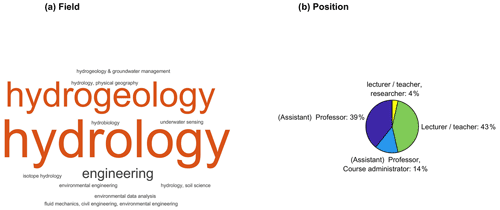
Figure 2These respondents indicated in which part of water science they work in panel (a), represented qualitatively as a word cloud. The larger the font, the more respondents indicated feeling connected to and working in it (multiple answers were possible). The different roles (levels) in water education indicated by the respondents given as a percentage (b).
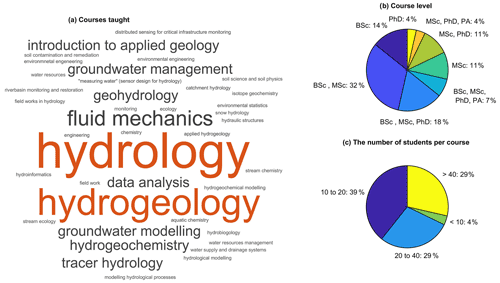
Figure 3These respondents indicated which courses they taught, represented as a word cloud (a). The larger the font, the more respondents indicated teaching the course (multiple answers were possible). The percentage of respondents teaching BSc- to PhD-level or post-academic (PA) courses (b). The percentage of respondents indicated to have had <10 up to >40 students in their course (c).
3.3 Water education during COVID-19
The beginning of 2020 came as a shock to research (CUAHSI Board of Directors & Officers, 2022), and especially for education when campus-based university education came to a halt. Hydrological education was forced to suddenly move from classroom to online teaching, which was only possible because of the available digital tools and technical infrastructure (Fig. 5). The practiced teaching format remained lectures (Fig. 4a). Instead, practical teaching methods, which are so important for hydrology, were terminated. To some extent, an increase in the use of “exotic” teaching formats such as pre-recorded videos and group discussions could be noticed (Fig. 4a).
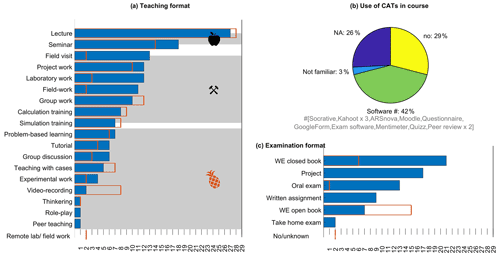
Figure 4Traditional, practical, and exotic teaching formats indicated as 12, 1, or 12, respectively, used by the respondents before pre-COVID-19 measures (blue bars) and during COVID-19 measures (orange bar), where the x axis indicates the number of respondents (a). Percentage of respondents who indicated using classroom assessment techniques (CATs), including a specific software application/tool, not answered (NA), not, or not familiar (b). The respondents indicated using different examination formats before pre-COVID-19 measures (blue bars) and during COVID-19 measures (orange bar), where the x axis indicates the number of respondents (c).
Gonzalez et al. (2020) and Keržič et al. (2021) found that students were more focused during the pandemic, resulting in a positive study performance. By contrast, our hydrology respondents indicated that students were less focused during the lectures (Fig. 6d), student learning was impacted negatively (reported by 67 % of the respondents), and it was difficult to assess whether students reached their learning goals (Fig. 7e). These opposite observations could be explained by the use of CATs by Gonzalez et al. (2020) compared to the majority of the respondents of this study, who indicated not using or not being familiar with CATs during pre-COVID-19 teaching (Fig. 4b). Hence, it is likely that CATs were also not used during COVID-19, making it hard for teachers to give student feedback and gauge the student performance in the online environment (Fig. 6d–f). Examinations changed from project work and written exams (open- and closed-book) on campus (Fig. 4c) to open-book take-home exams (Figs. 4c and 6b). Respondents indicated an overall negative up to very negative teaching experience due to an extra effort to prepare for exams, trusting students not to cheat (which is hard to control), and lowering the level of the exams and the quality of the education, hence the overall negative teaching experiences (open feedback, Figs. 7c and g, 8). In addition, from open feedback we derived challenges concerning digital poverty, digital equality, and digital competency faced in hydrology education during COVID-19:
-
Teachers needed additional training to get accustomed to new digital tools and the virtual learning environment, including acquiring computer literacy
-
Required personal electronic devices, e.g. laptops, tablets with pens, video cameras, microphones and headsets, lights and stable Internet connections
-
Solving various computer problems (e.g. installing software and driver conflicts when attaching new devices and connection issues)
-
Rethinking the organization of the learning process and designing a new time plan when moving the classes online
-
Change from student-focused to teacher-focused surface learning
-
Data privacy and cyber security for students and staff
-
Adjusting the online courses to students with visual or hearing problems
The survey focused mainly on the year 2020, when some respondents indicated perceiving a difference between the spring and autumn semesters (Fig. 7h). The perceived differences are likely because different European countries imposed different infection control measures during the ongoing pandemic (ECDC, 2022; Alemanno, 2020), where instead of COVID-19 distance teaching, pre-COVID-19 teaching styles were again possible (campus teaching including laboratory work and fieldwork). After the finalization of the survey, additional hybrid formats appeared (e.g. students attending lectures in class and online). Such hybrid formats require other skills compared to on-campus or distance teaching only and require further research.
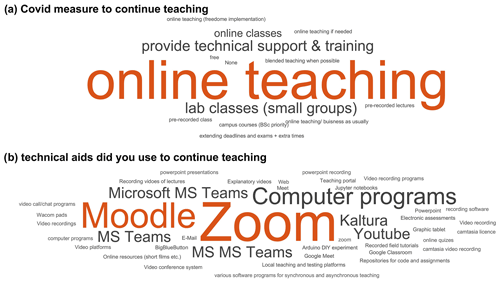
Figure 5Measures (a) and technical aids (b) used by the respondents to continue teaching. The larger the font, the more respondents indicated using the measure or aid (multiple answers were possible).
The challenges and negative hydrology teaching experience during 2020 could have been due to the sudden change from classroom to online teaching. Due to the lack of experience in online education, different teachers shared knowledge and resources on social media and websites (Table 2). Respondents indicated that universities provided technical support and training for distance teaching (Fig. 5a), which probably focused on technical rather than lesson design in an online environment. Generally, when teaching a course it is recommended to follow an integrated course design (Fink, 2013) which was described for hydrology classroom teaching by Wagener et al. (2012) as the pre-COVID-19-developed Modular Curriculum for Hydrologic Advancement (MOCHA) ABCD lesson design concept consisting of planning, delivering, and evaluating to improve for next time. As described by Ellis et al. (2009) and Berry (2019), teaching in the online environment needs to consider the online digital context in the lecture design, workload, and interactivity and engage students through personal and professional interaction. Despite this framework, some exposure to virtual education, and how to optimize the student e-learning experience (Berry, 2019; Ellis et al., 2009; Lehman, 2006), the change to online teaching was somewhat improvised and a new experience for most of the teaching staff and students. In addition, the teaching material, tailored to classroom teaching, needed to be rapidly adjusted for online distance teaching. When teaching a class for the first time, the preparation can range between 3 and 5 h for a 1 h class, while subsequent years require only 1 to 2 h (Wagener et al., 2007). Similarly, teaching during COVID-19 required extra time for planning, delivering, and wrapping up teaching activities (Fig. 6). The extra time was comparable to the teaching load when preparing a new course, but it is expected to decrease the longer the COVID-19 situation lasts.
Table 2Overview of different positive novel teaching methods and resources (see the link in the bibliography for more content).
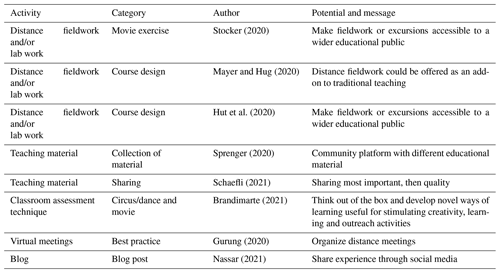
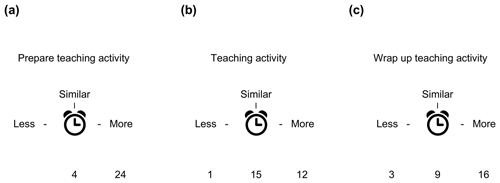
Figure 6The amount of time (less, similar, or more) the respondents indicated having spent compared to pre-COVID-19 measures preparing the teaching activity (a), during the teaching activity (b), and wrapping up the teaching activity (c). The numbers indicate the number of respondents.
A time-independent factor contributing to the negative learning experience could be the loss of human interaction (Marzoli et al., 2021; Eklund et al., 2022; Ljunghammar and Waxell, 2020; Romeo et al., 2021). Traditional classroom teaching comprises student–teacher and student–student interaction (discussing e.g. lecture content and social and private life). Instead, in distance education such important physical, psychological, and social factors are missing or are limited (Berry, 2019; Lehman, 2006; Raffetti and Di Baldassarre, 2022), affecting the students' metacognition (Romeo et al., 2021; Eklund et al., 2022). A lack of social interaction can make students lose self-motivation or social skills or become unaware of limits and obligations, leading potentially to anxiety and depression (Marzoli et al., 2021; Eklund et al., 2022; Ljunghammar and Waxell, 2020; Romeo et al., 2021). This demonstrates that for students it is not sufficient to acquire only theoretical knowledge. However, it is necessary to grow as a person, apply the newly gained knowledge, and learn from mistakes in a stimulating and social environment (Ferretti et al., 2019; Glagovich and Swierczynski, 2004; Ryoo and Kekelis, 2018).
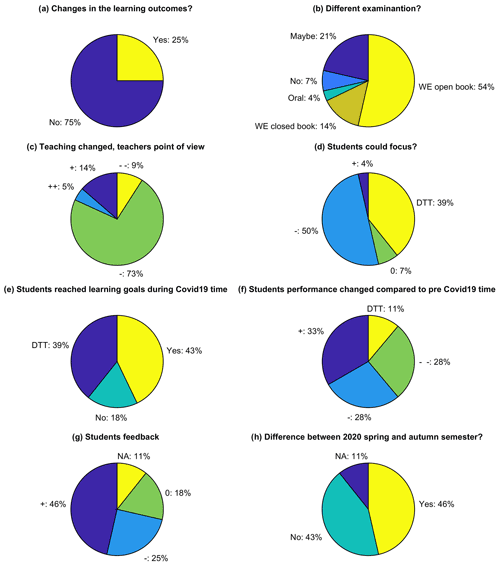
Figure 7The percentage of respondents indicating that (a) the learning outcomes changed, (b) different examinations were used (written exam as WE), (c) teaching changed from a teacher's point (d), students could focus, students could reach learning goals during COVID-19 measures (e), students' performance changed compared to pre-COVID-19 measures (f), the student feedback (g) and whether there was a difference in teaching between the 2020 spring and autumn semesters, with positive or more (+), neutral (0), negative (–), very negative (–), and difficult to tell (DTT).
Twenty-eight respondents to our survey, working at universities across Europe in the field of hydrology, answered that, pre-COVID-19, conservative classroom lectures, laboratory work, and fieldwork were commonly used teaching formats in courses with 10 to more than 40 students. Similar results were found in the literature. Additionally, our survey indicated that less than half of the respondents indicated using classroom assessment techniques to improve and gauge the students' performance. Students were examined with closed-book or oral exams.
COVID-19 forced hydrological education to move suddenly from classroom to online teaching, which perhaps was only possible because of the available digital tools and technical infrastructure. The practiced teaching format remained lectures. Instead, practical teaching methods, which are so important for hydrology, were terminated.
Overall, the majority of the respondents reported that the COVID-19 crisis impacted student learning negatively up to very negatively. The online interaction was more difficult and cost extra time. Teachers lost student contact, and it was difficult to assess whether students achieved the learning outcomes. However, most of the respondents reported that they did not use classroom assessment techniques. The most affected learning activities were the ones that could not be moved to online teaching, such as laboratory work and fieldwork (Fig. 8). As discussed by Wagener et al. (2012), laboratory work and fieldwork were already strongly reduced from the teaching curricula in many universities in pre-COVID-19 times, reaching a critical level. Hence, due to COVID-19 the important knowledge of process understanding in hydrology will be missing for at least several cohorts of hydrologists. Transferring passion for water-related topics and hydrological knowledge in a stimulating and social environment was disrupted, affecting several cohorts of students. In this way, COVID-19 caused a secondary effect on society and a loss of knowledge and skills, which are needed to tackle the existing and future local and global environmental challenges. This highlights that COVID-19 added a new layer of complexity on top of the already existing challenges in hydrological education pointed out by Wagener et al. (2012).
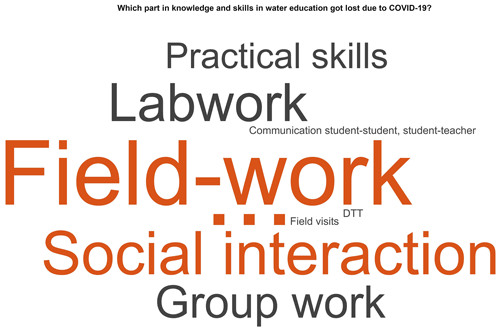
Figure 8Which part in knowledge and skills in water education got lost due to COVID-19, indicated by the respondents. The larger the font, the more respondents indicated using the measure or aid (multiple answers were possible).
In the open feedback, respondents expressed the frustration that COVID-19 caused in teaching. However, next to all the COVID-19 misery, a spirit of optimism and a time of change could be noticed. COVID-19 made it possible to explore, improvise, and use novel teaching methods. Positive aspects were bottom-up initiatives sharing knowledge and resources on different social media and websites. Such efforts highlight that, even during extremes such as COVID-19, with creativity and improvising and sharing technical aspects and material as a community, e.g. in Sprenger (2020), it was possible to teach hydrology and overcome limitations during and beyond the pandemic. To learn from this COVID-19 experience and improve the online teaching and learning experience, the MOCHA ABCD lesson design, proposed by Wagener et al. (2012), should be adapted for the online environment. Such a to-be-developed “eMOCHA” lesson design for the online environment should include suggestions from e.g. Ellis et al. (2009) and Berry (2019b) considering the online digital context in the lecture design, workload, and interactivity and engage students through personal and professional interaction. Furthermore, one needs to evaluate and study which teaching formats worked, which elements are valuable to keep, and whether we, as a community, want to go back to the more traditional teaching styles in post-COVID-19 hydrology and water education or take the opportunity and finally take the next step in teaching hydrology and water education. Especially the range of practical and “exotic” teaching formats practiced during COVID-19 (Fig. 4a), home experiments using improvised low-budget or high-cost materials similar to e.g. Hut et al. (2020) and Kinar (2021), or learning how to program, e.g. Kelleher et al. (2022), taught at distance, could be an add-on to classical classroom teaching. Such activities promote learning by not only considering the lower cognitive domains of Bloom's taxonomy (a.k.a. Bloom's taxonomy of learning objectives, which identifies six cognitive levels from simple to more complex behavior, including knowledge, comprehension, application, analysis, synthesis, and evaluation/creation; Gogus, 2012), but also stimulating the higher cognitive levels by synthesizing, evaluating, and discussing water concepts in a safe social environment which facilitates the production of new original work. Even more, it could be a solution to repair the damage (reduced practical training) in hydrology and water education by making practical and “exotic” teaching formats accessible to all hydrology and water students. The aforementioned initiatives show that hydrology is not only a scientific community effort, but that above all it needs “a hydrological community to raise a hydrologist” (Wagener et al., 2012) who can solve old (Blöschl et al., 2019) and pose new hydrological questions.
The presented results are a first snapshot overview of how COVID-19 affected water education throughout Europe. The long-term effect on water education is uncertain and needs further analysis focusing not only on education, but also on social interactions, gender, and regional differences, to prepare hydrology education for future disruptive natural or other hazardous events.
The anonymized response data are available as Supplement data, and the MATLAB script (to make Figs. 2–8) is available at https://github.com/hydrodroplets/COVID-19snapshotsample (last access: 5 August 2022; Fischer and Tatomir, 2022).
The supplement related to this article is available online at: https://doi.org/10.5194/gc-5-261-2022-supplement.
BF and AT both designed, delivered and analyzed the survey. BF and AT co-wrote the paper.
The contact author has declared that none of the authors has any competing interests.
The work performed in this study is original, reflects the author's view and it does not engage in any form of malicious harm to other persons. The performed survey and literature study took place as part of a pedagogical training course at Uppsala University in 2020, the first year of the COVID-19 pandemic. This triggered the authors’ curiosity about how COVID-19 might impact European water education. The survey took place in the wider research network of the authors involved in professionals in university education across Europe (including student assistants, PhD students, lecturers/teachers, (assistant) professors, course administrators, and researchers). The link to the online survey (Google Form) was sent by e-mail with a request to spread the survey within the respective departments. In addition, a post with the link to the survey was posted to a hydrology group on the social network Facebook. The authors of this group did not participate in the survey.
The survey was designed carefully to ensure that it did not cause any psychological or emotional distress. Participation was voluntary and anonymous, and participants were given the opportunity to consent or refuse participation. Participants could indicate voluntarily their e-mail address to receive the outcome of this study. The responses were kept confidential, no sensitive or identifying information was collected, and inappropriate wording in open-ended feedback, likely due to frustration, was represented in neutral wording covering the context. The anonymous data are provided as a supplement.
Publisher’s note: Copernicus Publications remains neutral with regard to jurisdictional claims in published maps and institutional affiliations.
This article is part of the special issue “Education and professional development in hydro-environmental engineering”. It is a result of the 6th IAHR Europe Congress 2020, Warsaw, Poland, 30 June–2 July 2020.
We thank all respondents for their valuable time answering our survey, allowing a glimpse into how COVID-19 impacted European water education. In addition, we thank the team of the EGU HS blog and contributing bloggers listed in this paper as well as our colleagues who participated in Academic Teacher Training Course 3 at Uppsala University (2019), especially Emma Lundkvist, Peter Reinholdsson, and Elena Mondino, for their valuable discussions, input, and feedback. Furthermore, we thank Steve Rogers (editor), Rolf Hut (referee), and Nicholas Kinar (referee) for their comments and suggestions that helped to significantly improve the manuscript.
This paper was edited by Steven Rogers and reviewed by Rolf Hut and Nicholas Kinar.
AghaKouchak, A., Nakhjiri, N., and Habib, E.: An educational model for ensemble streamflow simulation and uncertainty analysis, Hydrol. Earth Syst. Sci., 17, 445–452, https://doi.org/10.5194/hess-17-445-2013, 2013.
Alemanno, A.: The European Response to COVID-19: From Regulatory Emulation to Regulatory Coordination?, Euro. J. Risk Reg., 11, 307–316, https://doi.org/10.1017/err.2020.44, 2020.
Aristovnik, A., Keržič, D., Ravšelj, D., Tomaževič, N., and Umek, L.: Impacts of the COVID-19 Pandemic on Life of Higher Education Students: A Global Perspective, Sustainability, 12, 8438, https://doi.org/10.3390/su12208438, 2020.
Assendelft, R. S. and van Meerveld, H. J. I.: A Low-Cost, Multi-Sensor System to Monitor Temporary Stream Dynamics in Mountainous Headwater Catchments, Sensors, 19, 4645, https://doi.org/10.3390/s19214645, 2019.
Berry, S.: Teaching to connect: Community-building strategies for the virtual classroom, Online Learning, 23, 164–183, 2019.
Beven, K.: Advice to a young hydrologist, Hydrol. Process., 30, 3578–3582, https://doi.org/10.1002/hyp.10879, 2016.
Blöschl, G., Carr, G., Bucher, C., Farnleitner, A. H., Rechberger, H., Wagner, W., and Zessner, M.: Promoting interdisciplinary education – the Vienna Doctoral Programme on Water Resource Systems, Hydrol. Earth Syst. Sci., 16, 457–472, https://doi.org/10.5194/hess-16-457-2012, 2012.
Blöschl, G., Bierkens, M. F. P., Chambel, A., et al.: Twenty-three unsolved problems in hydrology (UPH) – a community perspective, Hydrol. Sci. J., 64, 1141–1158, https://doi.org/10.1080/02626667.2019.1620507, 2019.
Blume, T., van Meerveld, I., and Weiler, M.: The role of experimental work in hydrological sciences – insights from a community survey, Hydrol. Sci. J., 62, 334–337, https://doi.org/10.1080/02626667.2016.1230675, 2017.
Bormann, I., Brøgger, K., Pol, M., and Lazarová, B.: COVID-19 and its effects: On the risk of social inequality through digitalization and the loss of trust in three European education systems, Euro. Educ. Res. J., 20, 610–635, https://doi.org/10.1177/14749041211031356, 2021.
Brandimarte, L.: The pandemic made her join the circus (by Luigia Brandimartes KTH in collaboration with Stockholm University of the Arts), https://www.kth.se/en/abe/nyheter/pandemin-drev-henne-till-cirkusen-1.1122914, last access: 24 November 2021.
CUAHSI Board of Directors & Officers: COVID-19 Impacts Highlight the Need for Holistic Evaluation of Research in the Hydrologic Sciences, Front. Surg., 58, e2021WR030930, https://doi.org/10.1029/2021WR030930, 2022.
de Koning, R., Egiz, A., Kotecha, J., Ciuculete, A. C., Ooi, S. Z. Y., Bankole, N. D. A., Erhabor, J., Higginbotham, G., Khan, M., Dalle, D. U., Sichimba, D., Bandyopadhyay, S., and Kanmounye, U. S.: Survey Fatigue During the COVID-19 Pandemic: An Analysis of Neurosurgery Survey Response Rates, 8, https://doi.org/10.3389/fsurg.2021.690680, 2021.
Douven, W., Mul, M. L., Fernández-Álvarez, B., Lam Hung, S., Bakker, N., Radosevich, G., and van der Zaag, P.: Enhancing capacities of riparian professionals to address and resolve transboundary issues in international river basins: experiences from the Lower Mekong River Basin, Hydrol. Earth Syst. Sci., 16, 3183–3197, https://doi.org/10.5194/hess-16-3183-2012, 2012.
Eagleson, P. S.: Opportunities in the hydrologic sciences: An open invitation for contributions, EOS, 69, 817–821, https://doi.org/10.1029/88EO01080, 1988.
ECDC: Data on country response measures to COVID-19, European Centre for Disease Prevention and Control, https://www.ecdc.europa.eu/en/publications-data/download-data-response-measures-covid-19, last access: 10 June 2022.
Eklund, R., Bondjers, K., Hensler, I., Bragesjö, M., Johannesson, K. B., Arnberg, F. K., and Sveen, J.: Daily uplifts during the COVID-19 pandemic: what is considered helpful in everyday life?, BMC Public Health, 22, 85, https://doi.org/10.1186/s12889-022-12506-4, 2022.
Ellis, R. A., Ginns, P., and Piggott, L.: E-learning in higher education: some key aspects and their relationship to approaches to study, Higher Educ. Res. Develop., 28, 303–318, https://doi.org/10.1080/07294360902839909, 2009.
Ferretti, E., Rohde, K., Moore, G. P., and Daboval, T.: Catch the moment: The power of turning mistakes into “precious” learning opportunities, Paediatr Child Health, 24, 156–159, https://doi.org/10.1093/pch/pxy102, 2019.
Fink, L. D.: Creating significant learning experiences: an integrated approach to designing college courses, Revis and updat., Jossey-Bass, San Francisco, Jossey-Bass, ISBN 9781118692912, 2013.
Fischer, B. M. C.: How did Swedish water education got affected due to Covid19 measures?, SHR Monthly Flash, http://hydrologi.org/monthly-flash/, last access: 24 November 2021, 2020.
Fischer, B. M. C. and Tatomir, A.: How COVID-19 impacted European water education, COVID-19snapshotsample, Github [data set], https://github.com/hydrodroplets/COVID-19snapshotsample, last access: 5 August 2022.
Fischer, B. M. C., Rinderer, M., Schneider, P., Ewen, T., and Seibert, J.: Contributing sources to baseflow in pre-alpine headwaters using spatial snapshot sampling, Hydrol. Process., 29, 5321–5336, https://doi.org/10.1002/hyp.10529, 2015.
Floriancic, M. G., Fischer, B. M. C., Molnar, P., Kirchner, J. W., and van Meerveld, H. J. (Ilja): Spatial variability in specific discharge and streamwater chemistry during low flows: results from snapshot sampling campaigns in eleven Swiss catchments, Hydrol. Process., 1–20, 2019.
Foley, J. A., Ramankutty, N., Brauman, K. A., Cassidy, E. S., Gerber, J. S., Johnston, M., Mueller, N. D., O'Connell, C., Ray, D. K., West, P. C., Balzer, C., Bennett, E. M., Carpenter, S. R., Hill, J., Monfreda, C., Polasky, S., Rockström, J., Sheehan, J., Siebert, S., Tilman, D., and Zaks, D. P. M.: Solutions for a cultivated planet, Nature, 478, 337–342, https://doi.org/10.1038/nature10452, 2011.
Forest, J. J. and Altbach, P. G.: International handbook of higher education, Springer, https://doi.org/10.1007/978-1-4020-4012-2, 2006.
Fox, M. F. J., Hoehn, J. R., Werth, A., and Lewandowski, H. J.: Lab instruction during the COVID-19 pandemic: Effects on student views about experimental physics in comparison with previous years, Phys. Rev. Phys. Educ. Res., 17, 010148, https://doi.org/10.1103/PhysRevPhysEducRes.17.010148, 2021.
French, S. and Kennedy, G.: Reassessing the value of university lectures, null, Teaching in Higher Education, 22, 639–654, https://doi.org/10.1080/13562517.2016.1273213, 2017.
Garreta-Domingo, M., HernÃ!`ndez-Leo, D., and Sloep, P. B.: Evaluation to support learning design: Lessons learned in a teacher training MOOC, Aust. J. Educ. Technol., 34, https://doi.org/10.14742/ajet.3768, 2018.
Gideon, L.: Handbook of survey methodology for the social sciences, Springer, New York, NY, 520, https://doi.org/10.1007/978-1-4614-3876-2, 2012.
Glagovich, N. M. and Swierczynski, A. M.: Teaching Failure in the Laboratory, J. College Sci. Teach., 33, 45–47, 2004.
Gleeson, T., Allen, D. M., and Ferguson, G.: Teaching hydrogeology: a review of current practice, Hydrol. Earth Syst. Sci., 16, 2159–2168, https://doi.org/10.5194/hess-16-2159-2012, 2012.
Gogus, A.: Bloom's Taxonomy of Learning Objectives, in: Encyclopedia of the Sciences of Learning, edited by: Seel, N. M., Springer US, Boston, MA, 469–473, https://doi.org/10.1007/978-1-4419-1428-6_141, 2012.
Goldstein, G. S.: Using Classroom Assessment Techniques in an Introductory Statistics Class, College Teach., 55, 77–82, https://doi.org/10.3200/CTCH.55.2.77-82, 2007.
Gonzalez, T., de la Rubia, M. A., Hincz, K. P., Comas-Lopez, M., Subirats, L., Fort, S., and Sacha, G. M.: Influence of COVID-19 confinement on students' performance in higher education, PLOS ONE, 15, 1–23, https://doi.org/10.1371/journal.pone.0239490, 2020.
Gurung, A. B.: Virtual Meetings: Hypnotic sedative or effective stimulant?, EGU Blogs, EGU HS devisions, https://blogs.egu.eu/divisions/hs/2021/02/24/open-teaching-to-navigate-hydrology/ (last access: 10 June 2022), 2020.
Haley, C., Lee, J., Xun, H., Yesantharao, P., Nolan, I. T., Harirah, M., Crowe, C. S., Lopez, J., Morrison, S. D., Drolet, B. C., and Janis, J. E.: The Negative Impact of COVID-19 on Medical Education amongst Medical Students Interested in Plastic Surgery: A Cross-sectional Survey Study, Plastic and Reconstructive Surgery – Global Open, https://doi.org/10.1097/GOX.0000000000003535, 9, 2021.
Hund, S. V., Johnson, M. S., and Keddie, T.: Developing a hydrologic monitoring network in data-scarce regions using open-source arduino dataloggers, Agr. Environ. Lett., 1, 160011, https://doi.org/10.2134/ael2016.02.0011, 2016.
Hut, R., Weijs, S., and Luxemburg, W.: Using the Wiimote as a sensor in water research, Water Resour. Res., 46, W12601, https://doi.org/10.1029/2010WR009350, 2010.
Hut, R. W., Pols, C. F. J., and Verschuur, D. J.: Teaching a hands-on course during corona lockdown: from problems to opportunities, Phys. Educ., 55, 065022, https://doi.org/10.1088/1361-6552/abb06a, 2020.
John, C. M. and Khan, S. B.: Mental health in the field, Nat. Geosci., 11, 618–620, https://doi.org/10.1038/s41561-018-0219-0, 2018.
Karachalios, T., Kanellopoulos, D., and Lazarinis, F.: Arduino sensor integrated drone for weather indices: a prototype for pre-flight preparation, Inf. Technol. Appl., 21, 5–16, https://doi.org/10.48550/arXiv.2106.16083, 2021.
Kaspersma, J. M., Alaerts, G. J., and Slinger, J. H.: Competence formation and post-graduate education in the public water sector in Indonesia, Hydrol. Earth Syst. Sci., 16, 2379–2392, https://doi.org/10.5194/hess-16-2379-2012, 2012.
Kelleher, C. A., Gannon, J. P., Jones, C. N., and Aksoy, Ş.: Best Management Practices for Teaching Hydrologic Coding in Physical, Hybrid, and Virtual Classrooms, Front. Water, 4, 875732, https://doi.org/10.3389/frwa.2022.875732, 2022.
Keržič, D., Alex, J. K., Pamela Balbontín Alvarado, R., Bezerra, D. da S., Cheraghi, M., Dobrowolska, B., Fagbamigbe, A. F., Faris, M. E., França, T., González-Fernández, B., Gonzalez-Robledo, L. M., Inasius, F., Kar, S. K., Lazányi, K., Lazăr, F., Machin-Mastromatteo, J. D., Marôco, J., Marques, B. P., Mejía-Rodríguez, O., Méndez Prado, S. M., Mishra, A., Mollica, C., Navarro Jiménez, S. G., Obadić, A., Raccanello, D., Rashid, M. M. U., Ravšelj, D., Tomaževič, N., Uleanya, C., Umek, L., Vicentini, G., Yorulmaz, Ö., Zamfir, A.-M., and Aristovnik, A.: Academic student satisfaction and perceived performance in the e-learning environment during the COVID-19 pandemic: Evidence across ten countries, PLOS ONE, 16, e0258807, https://doi.org/10.1371/journal.pone.0258807, 2021.
Kinar, N. J.: Introducing electronic circuits and hydrological models to postsecondary physical geography and environmental science students: systems science, circuit theory, construction, and calibration, Geosci. Commun., 4, 209–231, https://doi.org/10.5194/gc-4-209-2021, 2021.
Kleinhans, M. G., Bierkens, M. F. P., and van der Perk, M.: HESS Opinions On the use of laboratory experimentation: “Hydrologists, bring out shovels and garden hoses and hit the dirt”, Hydrol. Earth Syst. Sci., 14, 369–382, https://doi.org/10.5194/hess-14-369-2010, 2010.
Lehman, R.: The role of emotion in creating instructor and learner presence in the distance education experience, J. Cog. Affect. Learn., 2, 12–26, 2006.
Likens, G. and Buso, D. .: Variation in Streamwater Chemistry Throughout the Hubbard Brook Valley, Biogeochemistry, 78, 1–30, https://doi.org/10.1007/s10533-005-2024-2, 2006.
Ljunghammar, T. and Waxell, A.: Conversion to digital distance educationStudent survey 2020, Analysis of open answers (campus students), Uppsala, https://mp.uu.se/en/web/info/undervisa/kvalitet-och-utvardering/enkatundersokningar/enkat-digital-omstallning (last access: 10 June 2022), 2020.
Lyon, S. W., Walter, M. T., Jantze, E. J., and Archibald, J. A.: Training hydrologists to be ecohydrologists: a ”how-you-can-do-it” example leveraging an active learning environment for studying plant–water interaction, Hydrol. Earth Syst. Sci., 17, 269–279, https://doi.org/10.5194/hess-17-269-2013, 2013.
Marzoli, I., Colantonio, A., Fazio, C., Giliberti, M., Scotti di Uccio, U., and Testa, I.: Effects of emergency remote instruction during the COVID-19 pandemic on university physics students in Italy, Phys. Rev. Phys. Educ. Res., 17, 020130, https://doi.org/10.1103/PhysRevPhysEducRes.17.020130, 2021.
Mayer, H. and Hug, M.: Hybrid field courses – a teaching format beyond emergency solution?, EGU Blogs, EGU HS devision, https://blogs.egu.eu/divisions/hs/2020/10/21/hybrid-field-courses-a-teaching-format-beyond-emergency-solution/ (last access: 10 June 2022), 2020.
Merwade, V. and Ruddell, B. L.: Moving university hydrology education forward with community-based geoinformatics, data and modeling resources, Hydrol. Earth Syst. Sci., 16, 2393–2404, https://doi.org/10.5194/hess-16-2393-2012, 2012.
Nash, J. E., Eagleson, P. S., Philip, J. R., van der Molen, W. H., and Klemeš, V.: The education of hydrologists (Report of an IAHS/UNESCO Panel on hydrological education), Hydrol. Sci. J., 35, 597–607, https://doi.org/10.1080/02626669009492466, 1990.
Nassar, J. B.: Equity, Diversity, and Inclusivity amidst COVID-19, EGU Blogs, EGU HS devisions, https://blogs.egu.eu/divisions/hs/2021/02/10/equity-diversity-and-inclusivity-amidst-COVID-19/ (last access: 10 June 2022), 2021.
Popescu, I., Jonoski, A., and Bhattacharya, B.: Experiences from online and classroom education in hydroinformatics, Hydrol. Earth Syst. Sci., 16, 3935–3944, https://doi.org/10.5194/hess-16-3935-2012, 2012.
Raffetti, E. and Di Baldassarre, G.: Do the Benefits of School Closure Outweigh Its Costs?, Int. J. Environ. Res. Pub. Health,, 19, https://doi.org/10.3390/ijerph19052500, 2022.
Reinfried, S., Tempelmann, S., and Aeschbacher, U.: Addressing secondary school students' everyday ideas about freshwater springs in order to develop an instructional tool to promote conceptual reconstruction, Hydrol. Earth Syst. Sci., 16, 1365–1377, https://doi.org/10.5194/hess-16-1365-2012, 2012.
Rodhe, A.: Physical models for classroom teaching in hydrology, Hydrol. Earth Syst. Sci., 16, 3075–3082, https://doi.org/10.5194/hess-16-3075-2012, 2012.
Romeo, M., Yepes-Baldó, M., Soria, M. Á., and Jayme, M.: Impact of the COVID-19 Pandemic on Higher Education: Characterizing the Psychosocial Context of the Positive and Negative Affective States Using Classification and Regression Trees, Front. Psychol., 12, https://doi.org/10.3389/fpsyg.2021.714397, 2021.
Rusca, M., Heun, J., and Schwartz, K.: Water management simulation games and the construction of knowledge, Hydrol. Earth Syst. Sci., 16, 2749–2757, https://doi.org/10.5194/hess-16-2749-2012, 2012.
Ryoo, J. and Kekelis, L.: Reframing “Failure” in Making: The Value of Play, Social Relationships, and Ownership, J. Youth Develop., 13, 49–67, https://doi.org/10.5195/jyd.2018.624, 2018.
Salling Olesen, H., Schreiber-Barsch, S., and Wildemeersch, D.: Editorial Learning in times of crisis, J. Res. Educ. Learn. Adults, 12, 245–249, https://doi.org/10.3384/rela.2000-7426.4083, 2021.
Schaefli, B.: Open teaching to navigate hydrology: how ready are we?, EGU Blogs, EGU HS devisions, https://blogs.egu.eu/divisions/hs/2021/02/24/open-teaching-to-navigate-hydrology/ (last access: 10 June 2022), 2021.
Schleicher, A.: The impact of COVID-19 on education insights from education at a glance 2020, https://www.oecd.org/education/the-impact-of-covid-19 (last access: 10 June 2022), 2020.
Seibert, J. and Vis, M. J. P.: Irrigania – a web-based game about sharing water resources, Hydrol. Earth Syst. Sci., 16, 2523–2530, https://doi.org/10.5194/hess-16-2523-2012, 2012a.
Seibert, J. and Vis, M. J. P.: Teaching hydrological modeling with a user-friendly catchment-runoff-model software package, Hydrol. Earth Syst. Sci., 16, 3315–3325, https://doi.org/10.5194/hess-16-3315-2012, 2012b.
Seibert, J., Uhlenbrook, S., and Wagener, T.: Preface “Hydrology education in a changing world,” Hydrol. Earth Syst. Sci., 17, 1393–1399, https://doi.org/10.5194/hess-17-1393-2013, 2013.
Sprenger, M.: When the students are gone: Transition to online teaching, EGU Blogs, EGU HS devisions, https://blogs.egu.eu/divisions/hs/2020/03/18/online-teaching/ (last access: 10 June 2022), 2020.
Stocker, B.: A university class with a somewhat different approach, EGU Blogs, EGU HS devisions, https://blogs.egu.eu/divisions/hs/2020/06/17/a-university-class-with-a-somewhat-different-approach/ (last access: 10 June 2022), 2020.
Stracke, C. M., Burgos, D., Santos-Hermosa, G., Bozkurt, A., Sharma, R. C., Swiatek Cassafieres, C., dos Santos, A. I., Mason, J., Ossiannilsson, E., Shon, J. G., Wan, M., Obiageli Agbu, J.-F., Farrow, R., Karakaya, Ö., Nerantzi, C., Ramírez-Montoya, M. S., Conole, G., Cox, G., and Truong, V.: Responding to the Initial Challenge of the COVID-19 Pandemic: Analysis of International Responses and Impact in School and Higher Education, Sustainability, 14, https://doi.org/10.3390/su14031876, 2022.
Temnerud, J., Seibert, J., Jansson, M., Bishop, K., and Carlo, M.: Spatial variation in discharge and concentrations of organic carbon in a catchment network of boreal streams in northern Sweden, J. Hydrol., 342, 72–87, https://doi.org/10.1016/j.jhydrol.2007.05.015, 2007.
Venhuizen, G. J., Hut, R., Albers, C., Stoof, C. R., and Smeets, I.: Flooded by jargon: how the interpretation of water-related terms differs between hydrology experts and the general audience, Hydrol. Earth Syst. Sci., 23, 393–403, https://doi.org/10.5194/hess-23-393-2019, 2019.
Vidon, P. G.: Field hydrologists needed: a call for young hydrologists to (re)-focus on field studies, Hydrol. Process., 29, 5478–5480, https://doi.org/10.1002/hyp.10614, 2015.
Wagener, T., Weiler, M., McGlynn, B., Gooseff, M., Meixner, T., Marshall, L., McGuire, K., and McHale, M.: Taking the pulse of hydrology education, Hydrol. Process., 21, 1789–1792, https://doi.org/10.1002/hyp.6766, 2007.
Wagener, T., Kelleher, C., Weiler, M., McGlynn, B., Gooseff, M., Marshall, L., Meixner, T., McGuire, K., Gregg, S., Sharma, P., and Zappe, S.: It takes a community to raise a hydrologist: the Modular Curriculum for Hydrologic Advancement (MOCHA), Hydrol. Earth Syst. Sci., 16, 3405–3418, https://doi.org/10.5194/hess-16-3405-2012, 2012.
Wanigasooriya, K., Beedham, W., Laloo, R., Karri, R. S., Darr, A., Layton, G. R., Logan, P., Tan, Y., Mittapalli, D., Patel, T., Mishra, V. D., Odeh, O., Prakash, S., Elnoamany, S., Peddinti, S. R., Daketsey, E. A., Gadgil, S., Bouhuwaish, A. E. M., Ozair, A., Bansal, S., Elhadi, M., Godbole, A. A., Axiaq, A., Rauf, F. A., Ashpak, A., and TMS Collaborative: The perceived impact of the Covid-19 pandemic on medical student education and training – an international survey, BMC Med. Educ., 21, 566, https://doi.org/10.1186/s12909-021-02983-3, 2021.
Westera, W. and Sloep, P. B.: Into the future of networked education, Cybereducation: The future of long distance learning, 115–36, 2001.
Wickert, A. D., Sandell, C. T., Schulz, B., and Ng, G.-H. C.: Open-source Arduino-compatible data loggers designed for field research, Hydrol. Earth Syst. Sci., 23, 2065–2076, https://doi.org/10.5194/hess-23-2065-2019, 2019.






